We may earn a commission if you make a purchase through the links on our website.
The Best Hypervisors
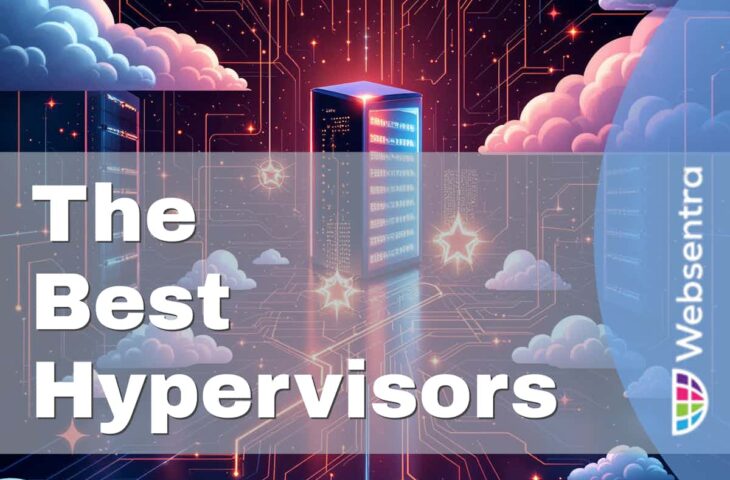
UPDATED: January 9, 2025
Virtualization is the foundational technology driving the rapid growth of cloud computing. Without it, the expansive, on-demand services we rely on in the cloud would not be possible. If you've ever run multiple operating systems on one computer, you're already familiar with basic virtualization concepts. Hypervisors are the foundation of virtualization. They sit between the physical hardware and virtual machines (VMs), managing the resources and ensuring each VM operates independently.
Choosing the right hypervisor that is fit for purpose is essential for effective virtualization and cloud strategy. Whether you’re managing a large data center or experimenting with virtual machines, the right hypervisor can significantly boost productivity and efficiency. In this article, we will explore the best hypervisors available today, highlighting their key features, benefits, and ideal use cases to help you make an informed decision for your virtualization needs.
Here is our list of the best Hypervisors and the methodologies considered:
- VMware vSphere/ESXi Industry leader with robust features for data center virtualization.
- Citrix XenServer A leading hypervisor known for its excellence for virtual desktops and applications.
- Microsoft Hyper-V A widely used hypervisor for Windows environments, offering integrated management and scaling for virtualized workloads.
- Nutanix AHV Nutanix's native hypervisor, designed to simplify virtualization and storage management in hyper-converged infrastructures.
- KVM (Kernel-based Virtual Machine) An open-source, Linux-based hypervisor, used for creating and managing virtual machines on Linux hosts.
- Xen Hypervisor An open-source hypervisor that has become a leading player in the world of virtualization.
The methodology for selecting these hypervisors involved a combination of market research, user reviews, and analysis of industry adoption in key sectors like cloud computing, virtualization, and enterprise IT. Other key criteria considered included popularity, performance, enterprise adoption, features, support, and the specific use cases each hypervisor excels in.
Popularity and widespread use in various industries were significant factors, with hypervisors that have a large customer base, a proven track record in production environments, and established support networks being prioritized. Performance considerations such as scalability, resource efficiency, and the ability to handle high workloads were also taken into account, as these are critical factors in enterprise and cloud environments. The inclusion of open-source options reflects their strong community backing, flexibility, and cost-effectiveness.
The Best Hypervisors
1. VMware vSphere
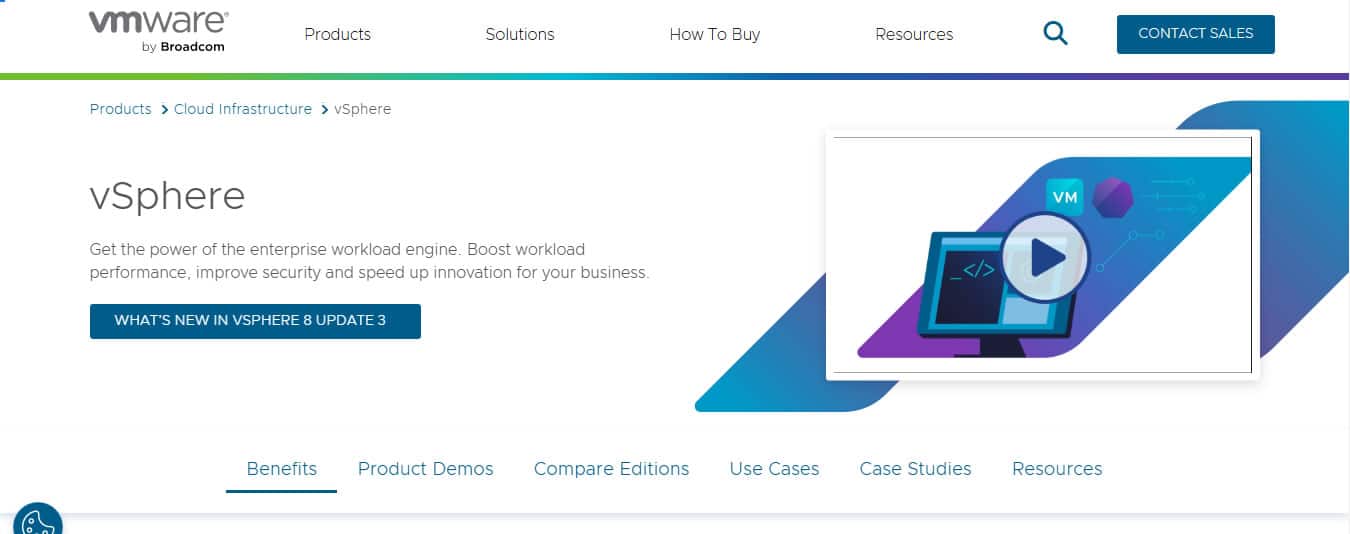
VMware vSphere is a widely used Type 1 hypervisor solution for enterprise-level virtualization. If you need a robust, scalable virtualization platform, vSphere is a strong choice. A recent hypervisor market report reveals that VMware leads the industry, with 84% of all hypervisors running vSphere. In terms of organizational adoption, 68% of organizations use VMware, making it the most popular hypervisor in the market.
Key Features:
- vCenter Server: Centralized management tool that allows for efficient administration of ESXi hosts and virtual machines (VMs) across multiple servers, simplifying scaling and maintenance.
- High Availability (HA): Offers automated failover capabilities for VMs in the event of hardware failure, ensuring minimal downtime and business continuity.
- vMotion: Allows live migration of VMs between hosts without downtime, facilitating workload balancing and hardware maintenance without service disruption.
- Distributed Resource Scheduler (DRS): Automatically manages resource allocation and load balancing between VMs across ESXi hosts to optimize performance.
- Storage vMotion: Enables the live migration of virtual machine disk files across storage devices without impacting VM availability.
- Fault Tolerance (FT): Provides continuous availability by creating a live shadow instance of a VM on another host, ensuring zero downtime in case of hardware failure.
- Security Features: Includes secure boot, encrypted VMs, and advanced firewall options to ensure data protection and compliance.
Why Do We Recommend It?
We recommend VMware vSphere/ESXi because it is a highly reliable, feature-rich Type 1 hypervisor that has become the industry standard for enterprise virtualization. I found that with a long track record of success and extensive support, VMware vSphere/ESXi is trusted by enterprises worldwide for mission-critical applications and workloads.
Who Is It Recommended For?
VMware vSphere is recommended for large enterprise environments where high availability, scalability, and centralized management of virtualized infrastructure are essential. It supports large-scale virtual machine deployment, resource management, and automation.
Pros:
- Mature Ecosystem: VMware has been in the virtualization market for years and has developed a rich ecosystem of tools, plugins, and integrations that can address a wide variety of use cases.
- Scalability: Supports large-scale environments with the ability to manage thousands of VMs and hosts across multiple data centers.
- Robust Management Tools: vCenter Server provides comprehensive monitoring, configuration, and troubleshooting tools, making it easy to manage large and complex virtual environments.
- Reliability: With features like HA, FT, and DRS, VMware vSphere ensures high availability and resilience, making it suitable for mission-critical workloads.
- Enterprise-Level Support: VMware offers extensive support options, including training, certifications, and a large ecosystem of third-party integrations, providing peace of mind for large enterprises.
Cons:
- Cost: VMware vSphere/ESXi can be expensive, particularly for small to medium-sized businesses. Licensing fees, as well as costs for advanced features like vCenter and additional management tools, can add up quickly.
- Vendor Lock-In: As a proprietary solution, VMware locks users into its ecosystem, making it difficult to migrate away without significant time and effort.
2. Citrix XenServer
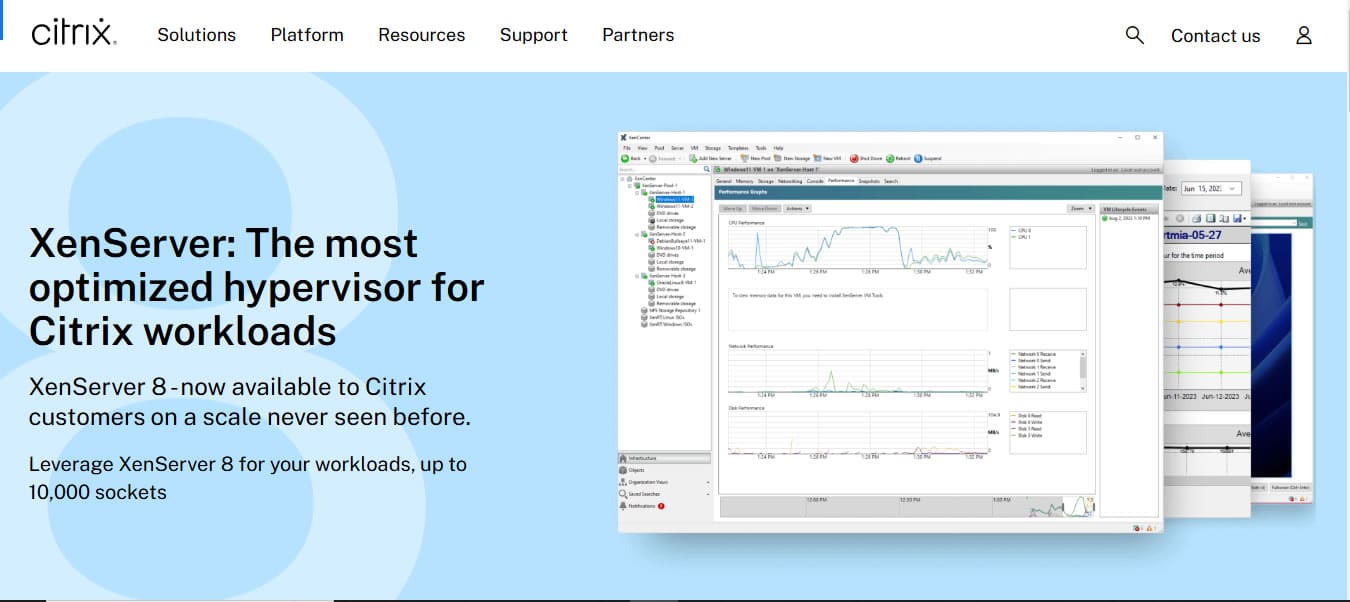
Citrix XenServer (Citrix Hypervisor), is a prominent hypervisor that has established itself as a key player in the virtualization market. It is based on the open-source Xen Project hypervisor, providing a highly efficient and scalable platform for managing virtualized workloads in both private and public cloud environments.
Key Features:
- XenMotion: This feature allows live migration of virtual machines (VMs) between XenServer hosts without downtime, similar to VMware's vMotion.
- High Availability (HA): Provides automatic failover of VMs to other hosts in the event of a hardware failure, ensuring uptime and reliability.
- Storage Integration: XenServer integrates with various storage solutions and supports Storage XenMotion, enabling live migration of VM disk files across storage devices without service interruption.
- Resource Pooling: Allows the creation of resource pools across multiple XenServer hosts to efficiently manage and allocate computing resources in large environments.
- Advanced Networking: Includes features like VLAN tagging, load balancing, and network traffic prioritization to improve network performance and manageability.
- Virtual Desktop Infrastructure (VDI): XenServer is well-suited for VDI, with tight integration with Citrix's XenDesktop and XenApp products.
Why Do We Recommend It?
Citrix XenServer is known for its enterprise-grade performance, ease of use, and strong support for virtual desktop infrastructure (VDI), making it a popular choice for organizations looking to optimize their cloud infrastructure. I noted that it supports a range of cloud environments, including hybrid cloud deployments. It can integrate with both private cloud infrastructure and major public cloud providers,
Who Is It Recommended For?
Citrix XenServer is recommended for organizations looking for a cost-effective, high-performance Type 1 hypervisor. It is an excellent choice for organizations looking for virtualization solutions, particularly those in VDI-focused environments.
Pros:
- Cost-Effective: It is relatively more affordable compared to other enterprise-level hypervisors, making it a good choice for smaller organizations or those on a tight budget.
- Open-Source Foundation: As part of the open-source Xen Project, XenServer benefits from community contributions and offers transparency in how it operates.
- Strong VDI Support: Citrix Hypervisor excels in VDI environments, particularly when integrated with Citrix XenDesktop and Citrix XenApp.
- Good Management Interface: The XenCenter management console is easy to use, providing a centralized point of control for administrators to manage all aspects of the hypervisor.
Cons:
- Complex Setup and Management: XenServer’s setup and configuration can be more challenging, particularly for those who are not familiar with the Xen ecosystem.
3. Microsoft Hyper-V
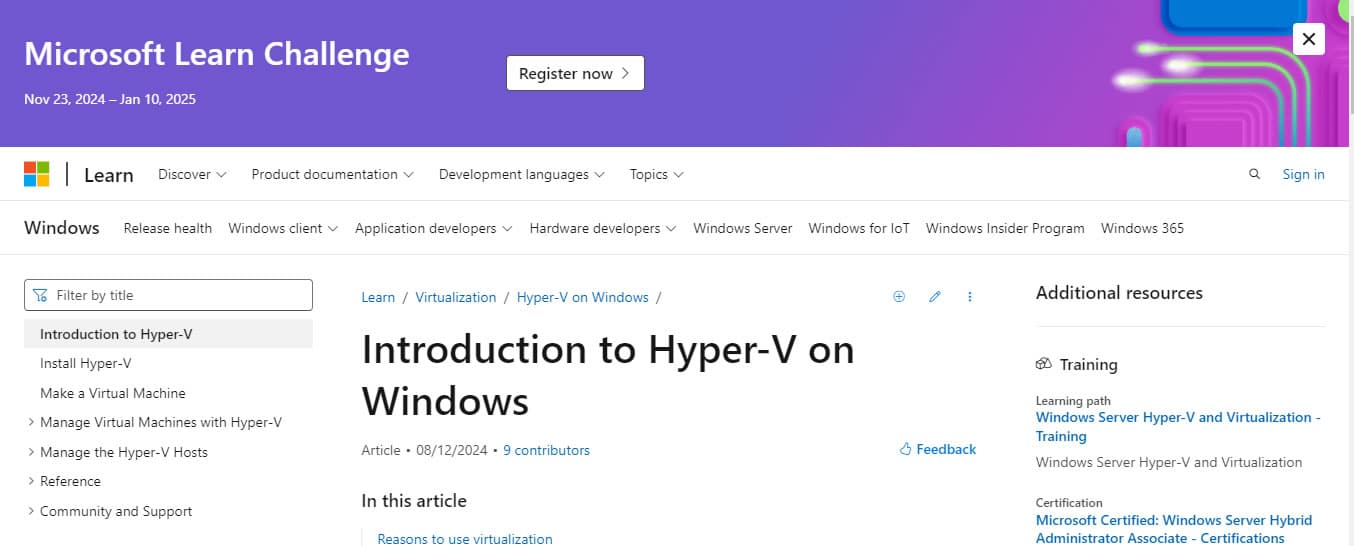
Hyper-V is Microsoft’s hypervisor solution, commonly used in Windows Server environments. Hyper-V is often used by businesses that already rely heavily on Microsoft technologies (like Windows Server and Active Directory). It provides an affordable and highly scalable solution for virtualizing both server and desktop workloads in enterprise environments.
Key Features:
- Live Migration: Allows VMs to be moved between physical hosts without downtime, enabling load balancing and hardware maintenance without service disruption.
- Virtual Machine Replication (VMM): Provides the ability to replicate VMs to a secondary site for disaster recovery, allowing quick recovery in case of a hardware failure or disaster.
- Hyper-V Manager: A GUI tool for managing virtualized environments, making it easier to configure and monitor VMs, networking, and storage.
- Storage and Network Virtualization: Includes features like Storage Spaces Direct for software-defined storage and Network Virtualization for network isolation and multi-tenancy.
- Hyper-V Replica: Allows for replication of VMs to a secondary site for disaster recovery, enabling quick failover in case of outages.
Why Do We Recommend It?
We recommend Microsoft Hyper-V due to its seamless integration with the Windows Server ecosystem. I learned that Hyper-V offers robust features such as live migration, high availability, and virtual machine replication, which are essential for creating resilient, scalable virtual environments.
Who Is It Recommended For?
Hyper-V is most suitable for organizations that are already deeply embedded in the Microsoft ecosystem, including businesses using Windows Server, Azure, and other Microsoft solutions. It is especially valuable for SMEs looking for a powerful and cost-effective virtualization solution, as it is included with Windows Server at no additional cost.
Pros:
- Cost-Effective: Hyper-V is included with Windows Server and Windows 10/11 (Pro or Enterprise), making it a cost-effective option for organizations that already use Microsoft products.
- Integration with Microsoft Ecosystem: Hyper-V integrates seamlessly with the Microsoft ecosystem, providing an efficient virtualization solution for enterprises already using Windows Server, Azure, and Active Directory.
- Enterprise-Grade Features: Hyper-V offers robust enterprise features, including live migration, storage and network virtualization, and high availability, making it suitable for mission-critical workloads.
- Scalability: It supports large-scale virtual environments, with the ability to manage thousands of VMs and hosts, making it suitable for businesses that need to scale.
- Security: With features like Shielded VMs, encryption, and secure boot, Hyper-V provides strong security options, protecting virtualized workloads from unauthorized access and ensuring compliance with security standards.
- Hybrid Cloud Integration: Hyper-V integrates well with Microsoft Azure, enabling businesses to create hybrid cloud environments and manage on-premises and cloud workloads efficiently.
Cons:
- More Optimized for Microsoft Ecosystem: While it supports Linux VMs, Hyper-V is more optimized for Windows-based workloads and may not be as effective in heterogeneous environments.
4. Nutanix AHV
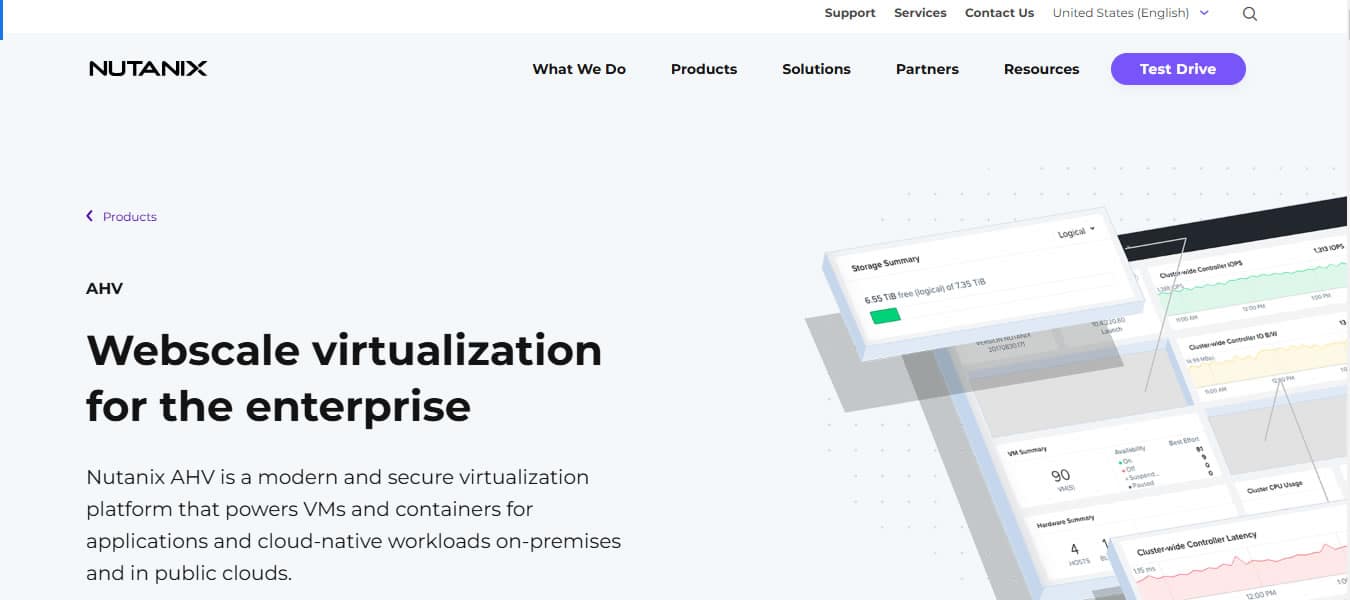
Nutanix AHV (Acropolis Hypervisor) is a powerful Type 1 enterprise-grade hypervisor designed to simplify the management of cloud infrastructure. It provides virtualization capabilities for workloads within Nutanix's hyper-converged infrastructure (HCI) environment. Initially released ten years ago, AHV has evolved into a leading virtualization platform, providing webscale virtualization for enterprises.
Key Features:
- Prism Management: AHV uses the Prism management interface, which provides a highly intuitive, user-friendly dashboard to manage virtual machines, storage, and clusters in one place.
- High Availability (HA): Provides automatic failover and continuous availability of virtual machines, ensuring uptime and resilience for critical applications.
- Distributed Storage Fabric (DSF): Nutanix's software-defined storage provides a scalable and high-performance storage solution that is directly integrated with AHV, improving storage efficiency and reducing latency.
- VM and Application Mobility: AHV supports the live migration of virtual machines without downtime, enabling flexibility and workload balancing across multiple nodes.
- Disaster Recovery: Built-in disaster recovery capabilities allow organizations to easily replicate workloads and recover from failures or outages.
- Security: AHV includes integrated security features such as VM encryption, role-based access control (RBAC), and secure boot, helping to protect sensitive data and applications.
Why Do We Recommend It?
We recommend Nutanix AHV as a top hypervisor because it is a highly integrated, software-defined solution designed for simplicity, scalability, and high performance. AHV offers tight integration with Nutanix’s storage, networking, and management layers, providing a unified platform for both virtualization and storage. I discovered that this seamless integration eliminates the need for third-party hypervisors.
Who Is It Recommended For?
Nutanix AHV is recommended for organizations seeking a highly scalable, cost-effective, and easy-to-manage hypervisor, particularly those implementing hyper-converged infrastructure (HCI) or hybrid cloud environments. Businesses that require a simplified solution to manage compute, storage, and networking in one integrated platform will greatly benefit from AHV.
Pros:
- Simplicity and Ease of Use: AHV is known for its straightforward management and user-friendly interface through Prism, which significantly reduces the complexity of managing virtualized environments.
- Cost-Effective: Nutanix AHV eliminates the need for third-party hypervisor licenses (like VMware or Hyper-V), reducing the total cost of ownership (TCO) for enterprises.
- Unified Platform: The integration of compute, storage, and networking into one platform allows for streamlined operations and better scalability, making it easier to manage and scale infrastructure.
- Scalability: Nutanix AHV can easily scale from a few nodes to a large number of nodes, providing businesses with the flexibility to grow their infrastructure as needed without disruptions.
- Hybrid Cloud and Multi-Cloud Capabilities: Nutanix AHV supports seamless integration with both public and private clouds, enabling a hybrid IT strategy that can flexibly expand to the cloud as needed.
- Performance: AHV’s direct integration with Nutanix's Distributed Storage Fabric ensures optimized performance, reduced latency, and efficient resource utilization across virtualized workloads.
Cons:
- Limited Ecosystem: While Nutanix AHV is a powerful fast-growing hypervisor provider, it is relatively newer in the market and has a smaller ecosystem compared to established hypervisors.
5. KVM (Kernel-based Virtual Machine)
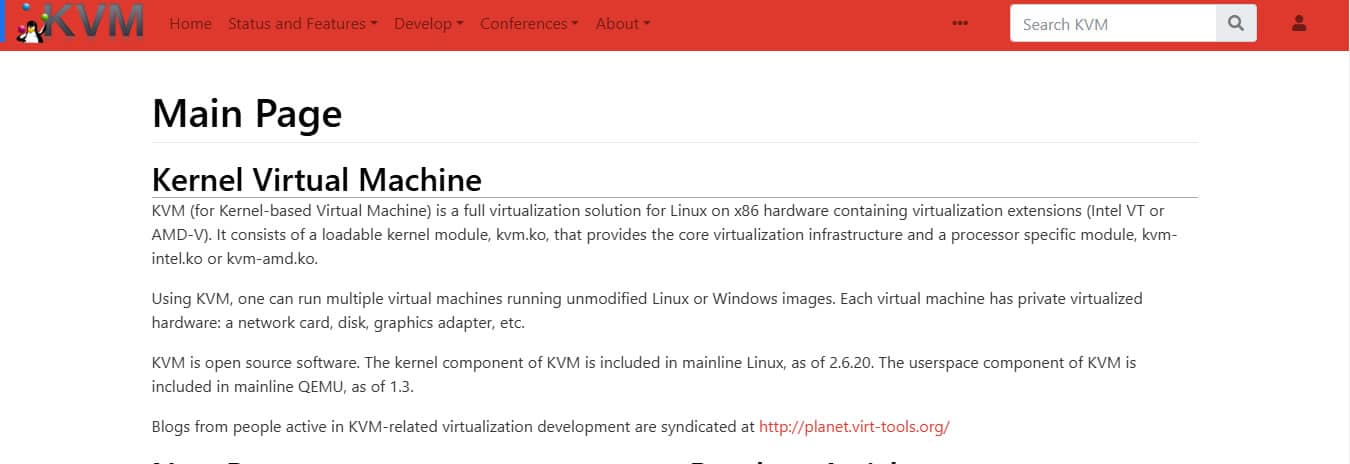
KVM is a Type 1 hypervisor built into Linux. It’s an open-source solution that allows you to run multiple virtual machines on a Linux host. If you're working in Linux environments, KVM hypervisor offers an efficient, flexible solution for managing VMs.
Key Features:
- Open-Source: KVM is fully open-source and integrated into the Linux kernel, ensuring complete transparency and no additional licensing costs.
- KVM Kernel Module: The core part of KVM is a kernel module that enables the Linux kernel to manage virtual machines.
- QEMU: While KVM provides the core virtualization features, QEMU (Quick Emulator) is used alongside it for virtual machine emulation, providing additional features such as device emulation and user interfaces.
- Libvirt: A management API that provides a uniform way to manage KVM virtual machines, supporting various management tools (like virt-manager) to create, configure, and control VMs.
- Live Migration: KVM supports live migration, enabling virtual machines to be moved between hosts with minimal downtime, ideal for load balancing or hardware maintenance.
- Virtual Machine Management: KVM is managed through tools such as OpenStack, providing a robust API and graphical interfaces for managing virtualized environments.
Why Do We Recommend It?
We recommend KVM as a top hypervisor due to its open-source nature, high performance, and strong flexibility in various environments. Integrated directly into the Linux kernel, KVM leverages the host's hardware virtualization extensions, ensuring efficient use of resources and superior performance. I observed that it supports a wide range of operating systems, including Linux, Windows, and others, making it versatile for different workloads.
Who Is It Recommended For?
KVM is widely used in cloud environments, particularly in OpenStack deployments, as it is tightly integrated with the Linux ecosystem. It's a popular choice for organizations that prefer open-source technologies and want a highly customizable and scalable virtualization solution.
Pros:
- Cost-Effective: As an open-source solution, KVM has no licensing fees, making it an affordable choice for businesses, especially in comparison to proprietary hypervisors like VMware or Hyper-V.
- Flexibility and Customization: KVM is highly customizable, allowing organizations to tailor it to their specific needs. Its open-source nature also means that users can modify the code to meet unique requirements.
- Excellent Performance: KVM provides high performance due to its tight integration with the Linux kernel and hardware virtualization support, allowing virtual machines to run efficiently with minimal overhead.
- Strong Community and Ecosystem: As part of the Linux kernel, KVM benefits from a large, active community, which contributes to rapid innovation, security patches, and a wealth of resources and tools.
- Integration with Cloud Platforms: KVM is widely used in OpenStack and other cloud platforms, providing a solid foundation for building private clouds.
Cons:
- Less Enterprise Support: While KVM is supported by major Linux distributions, it does not offer the same level of official, vendor-backed enterprise support as other major hypervisors.
6. Xen Hypervisor
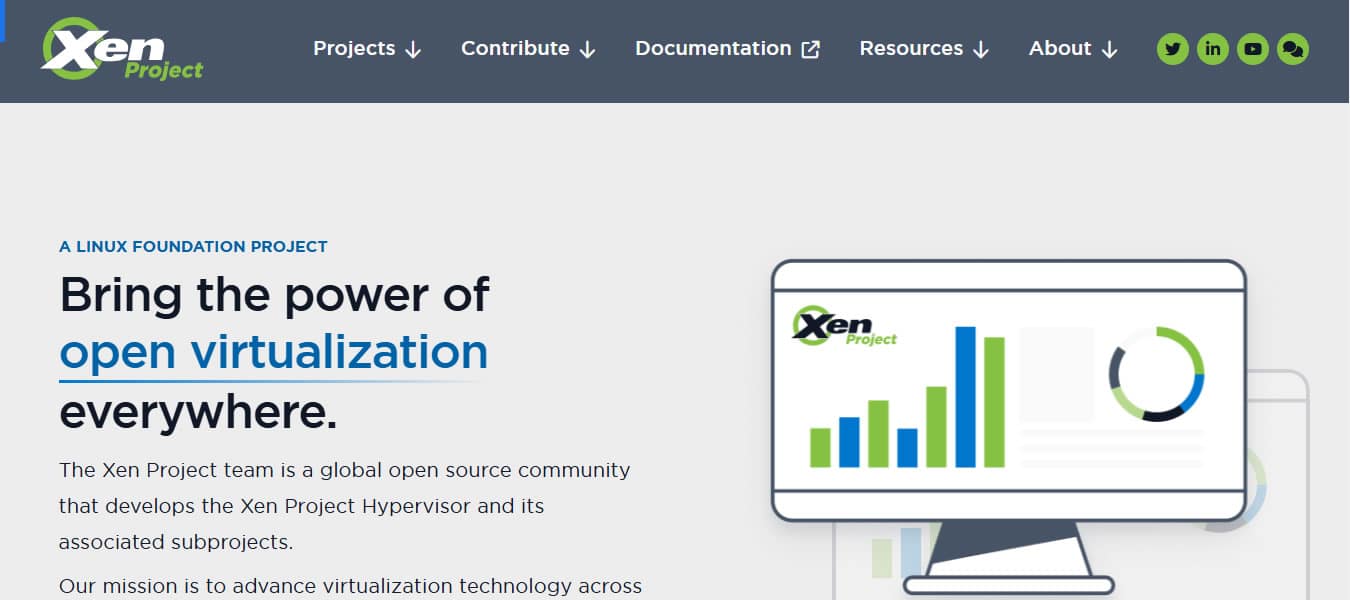
The Xen Hypervisor is an open-source type-1 hypervisor that has become a leading player in the world of virtualization. Unlike many other hypervisors, Xen is unique in that it is the only type-1 hypervisor available as open-source, making it a highly flexible and adaptable solution for a variety of use cases. Designed to run on x86 and ARM architectures, it can power both server virtualization and desktop virtualization, among other applications. This versatility makes the Xen Hypervisor a popular choice for organizations seeking scalable, cost-effective, and customizable virtualization solutions.
Key Features:
- Paravirtualization and Full Virtualization: Xen supports both paravirtualization (where the guest OS is modified to work more efficiently with the hypervisor) and full hardware-assisted virtualization (using Intel VT-x and AMD-V).
- Live Migration: Xen allows VMs to be moved between hosts with no downtime, which is crucial for load balancing, resource management, and minimizing downtime during maintenance.
- High Availability: It provides built-in features for clustering and automatic failover to ensure continuous availability of virtualized workloads.
- Security: Xen has a strong security model, with robust isolation of VMs, and supports security mechanisms like Xen Security Modules (XSM) and Access Control Lists (ACLs) to protect against unauthorized access.
- Multi-Tenancy Support: Xen is well-suited for multi-tenant environments, such as public or private cloud infrastructures, due to its ability to isolate workloads effectively.
- Flexible Storage and Networking: Xen supports various storage backends (e.g., iSCSI, NFS, local disk) and networking options (including bridged and NAT networking).
Why Do We Recommend It?
Xen has earned its reputation for reliability and performance, powering some of the largest clouds in production today. I noticed that the Xen Project is actively developed by a global community of researchers, developers, and companies who follow a strict governance process. This collaborative approach ensures that Xen continues to evolve.
Who Is It Recommended For?
Xen Hypervisor is recommended for organizations that require a high-performance, open-source virtualization solution with strong support for both paravirtualization and hardware-assisted virtualization. Its robust community-driven development and widespread use in cloud platforms like AWS makes it a solid choice for organizations that prioritize scalability, flexibility, and control over their virtualized infrastructure.
Pros:
- Cost-Effective: As an open-source project, Xen is free to use and does not require licensing fees, making it an attractive option for organizations that want to reduce costs on virtualization technology.
- Active Community Support: As part of the open-source community, Xen receives ongoing development, patches, and improvements, with a strong base of contributors and users.
- Flexibility: Xen supports a wide range of guest operating systems and virtualization modes (full and paravirtualized), making it highly versatile and capable of supporting diverse workloads.
- Security: Xen provides strong isolation between virtual machines and robust security features, which is vital for cloud providers and multi-tenant environments where data integrity is essential.
- Cloud Platform Integration: Xen is used as the basis for several cloud platforms, including AWS, and integrates well with OpenStack for private cloud deployments.
Cons:
- Less Commercial Support: Xen lacks a commercial vendor backing with enterprise-level support, which can be a challenge for organizations seeking guaranteed response times and support contracts for critical workloads.
- Smaller Ecosystem: Compared to other major hypervisors, Xen has a smaller ecosystem in terms of third-party integrations, commercial software compatibility, and a broader user base.